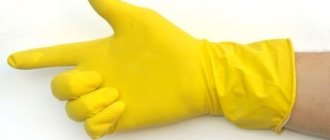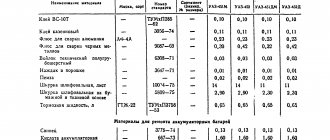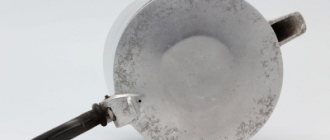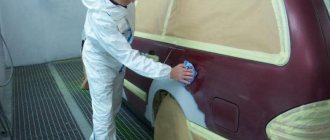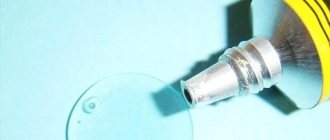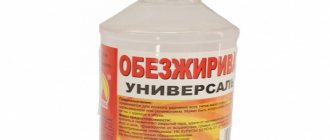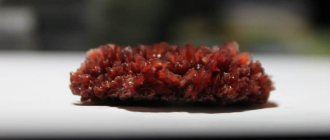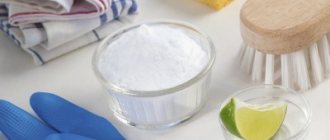Treating rust before painting the metal is a necessary component of repair work.
The purpose of this effect is not only to restore the metal product’s attractive appearance, but also to maintain functionality and extend its service life.
We’ll talk about how to treat metal from rust before painting it in this article.
Chemistry
Corrosion is a chemical process, so why not fight it with chemistry?
In every hypermarket or household chemicals store you will find many different products that can clean rust from cast iron, metal objects, plastic, etc. You must take into account the need for longer exposure to the products, and because of their cost, they are more suitable for small areas. During use, strictly follow the instructions and safety recommendations. Gloves are a must when handling chemicals, as are open windows (it's best to use rust removers outdoors).
WD-40
WD-40 is an anti-corrosion lubricant recommended for home removal of rust on metal and other materials. This product can be used to clean tools, garden equipment, cars, toys, furniture, and cauldrons from rust.
After use, the lubricant dries instantly and protects the metal from corrosive particles. It keeps the surface dry for a long time and prevents the reaction of water with metal.
WD-40 should be applied after removing rust from the surface. The product penetrates deeply into the surface, releasing rusty metal particles, therefore, remaining dirt can be easily wiped off.
Conversion
A modern method for processing rusty objects is conversion. It's about turning rust into a state that doesn't damage the metal. The products are produced in the form of a lubricant or spray.
Formalin
Rust from stainless steel is washed with the following mixture dissolved in 1 liter of water:
- formalin – 200 g;
- ammonium – 55 g;
- caustic soda – 53 g.
Place nails, nuts and bolts into the resulting cleaning solution and leave until the rusty coating is removed (up to 30 minutes). Rinse with water.
Mechanical cleaning
The essence of the method is to remove plaque using improvised or special devices. In practice, the following options are used:
Wire brushes, sponge brushes
In places where there is a lot of rust, on welded joints and seams, cleaning is done manually. The disadvantages of the process are rusty dust and scale residues.
A wire brush can be used to clean concrete slabs in your yard, cement floor, or wall. The stain is old - a product based on oxalic or other acid would be a good addition
Paint or dish scraper, metal sponge
They act similarly to sandpaper. It all depends on the age of the corrosion and accessibility to it. If the rust layer is thick, then even a screwdriver will do.
Aluminium foil
The material is almost always at hand, and it is very easy to use against surface corrosion stains. We crumple a small piece of foil well and make a dense, easy-to-work ball, which we will use to clean the surface. To make cleaning more effective, you can apply baking soda, lemon, vinegar, etc. to stains.
an old toothbrush can be used
Abrasive materials
In this case, sandpaper and sanding discs are used. You need to start with coarse-grained materials, gradually moving to the fine fraction. The work can be done manually, or you can use a power tool equipped with a special attachment. This will benefit the cause: more speed, less effort and 100% quality.
Sandblasting gun
To operate the installation, you need the gun itself to direct the sand, a compressor (the supply must be under pressure) and a tank with construction or river sand. The advantages of the method are the ability to reach the most inaccessible places, complete cleaning of the metal from old paint, carbon deposits, and scale.
You need to understand that such material processing can be done independently or used in combination with the following options. Alternatively, clean the surface using a mechanical means, and then finish the job using “chemical” substances. You need to look at the situation. In fact, it is not very wise to try to use more rust converter when you can get by with less simply by brushing it first.
How to remove rust from metals
Removing rust is a rather labor-intensive process, as it will require a lot of effort and time. Despite the availability of automatic means and expensive chemicals, it will not be possible to remove all the rust quickly.
In this chapter, we will pay special attention to the issue of how to remove rust at home using improvised means. https://www.youtube.com/embed/DFngjz8eKGA
The most popular and frequently used remedy is vinegar. If the part is small, then you can simply put it in a vinegar solution. If the item is large, then you need to make a compress from acetic acid - soak a rag in vinegar and put it on the metal. Wait a while, at least an hour, then clean with sandpaper or a wire brush. After cleaning, you can repeat the soaking.
Rust is removed in a similar way using other chemicals: oxalic acid, salt mixed with lemon juice. The purpose of these activities is to soften the rust so that it can easily come off the metal. It will not be possible to completely dissolve it.
Recommendations for surface treatment
To ensure that rust removal has maximum effect and does not cause harm, it is recommended to use the following expert advice:
- When using caustic acids and their solutions, it is necessary to use personal protective equipment, including a respirator.
- It is advisable to carry out work outdoors. Or in a room with very good ventilation.
- If there is significant corrosion, it is recommended to clean the metal with a stiff brush before treating with acid.
- After washing off the acid, the metal surface must be dried.
- Several acids should not be mixed together unless specified in the recipe.
Using purchased products to remove rust is more convenient than making your own solutions.
You will find a lot of useful information about rust removal in this section of the site.
Thermal cleaning of steel surfaces
To implement this method, you will need an industrial steam generator or, in extreme cases, a construction hair dryer. In this case, cleaning is based on the fact that the combination of scale of any chemical composition with the base metal is relatively small. Therefore, exposure to temperature, moisture, and changes in air flow speed will help remove surface rust.
The most effective cleaning using this method occurs if the surface to be treated is placed at some distance from the unit and the heated steam supply is turned on. A jet of steam-air mixture supplied under pressure first softens the scale and then crushes it into separate fragments, which are subsequently easily removed by an air stream.
In this way, you can remove rust from the surface of a steel door, ventilation duct, and other metal objects, the dismantling of which is either difficult or completely impossible.
Helpful information
Tips for removing rust:
- If acids or compounds based on them are used for processing, the product must be washed with a soda solution and then with clean water.
- When using professional anti-corrosion compounds, you must read the instructions. It will differ depending on the chosen product.
- Mechanical cleaning requires careful control of the pressing force.
- Converters can be used both to get rid of existing corrosion and to prevent it.
- Regardless of the chosen method of combating corrosion, safety precautions must be observed. Protect hands with gloves, eyes with special goggles, and respiratory organs with a respirator.
Causes of rust
Rust is the outward manifestation of metal corrosion as a result of the chemical process of oxidation. Outwardly it looks like a brown-red formation. Of all the metals, iron and its alloys are the most susceptible to corrosion. Even stainless steel, despite its name, can also rust.
Corrosion spots can cover the metal surface completely, or form locally in individual areas. It is not easy to remove rust from metal; it is much better to prevent its occurrence. If measures are not taken in time, over time the plaque can completely destroy the product.
When choosing tools made of stainless steel, remember that this material is also susceptible to corrosion and you need to monitor the products no less carefully than items made from other metals
At home, the main reasons for the appearance of traces of corrosion are constant exposure to water and high air humidity. The most susceptible to the formation of oxides are those objects that are located on the street: window grilles, iron door visors, padlocks, chains, pipes, etc.
At home, rust is most often found in areas with direct access to water, such as the bathroom and kitchen. Often, corrosion stains can be found on water faucets, chains or places of their attachment, on pipes.
Plumbing pipes are most susceptible to corrosion due to constant contact with water
Rust may be one of the reasons for the annoying squeaking of door hinges in your home.
It is important to understand that in addition to external discomfort, a coating of corrosion on hinges significantly increases their wear
Corrosion stains can significantly degrade the appearance of the product and shorten its service life.
Detailed inspection of the bike
In order not to rack your brains over how to remove rust from a bicycle, you need to understand that any prolonged contact with moisture has corresponding consequences. The bike should not be stored in a damp room; it must be wiped dry after washing and riding in the rain, and damaged nickel or chrome plating needs special attention. Therefore, when packing your bike for the winter, each time carefully inspect its metal parts for corrosion. This must be done before the opening of the new season.
Unusual ways
You can remove traces of corrosion using unusual but effective methods.
Coca Cola
You can quickly get rid of unpleasant traces of metal oxidation from a stroller, household utensils, and even a car body with the help of a popular drink - Coca-Cola. Soda should be poured into a plastic tray or container, and then items damaged by corrosion should be placed in it. Usually a few hours are enough for the drink to corrode even severe rust.
Soda can be used to remove rust from a circuit board or other delicate products. In this case, you need to soak a rag or sponge in Coca-Cola and wipe the surface. Repeat the action if necessary.
Ketchup or tomatoes
If there are expired canned tomatoes or ketchup in the refrigerator, do not rush to throw them away, as they can be used to clean metal from red marks. To eliminate them, just apply ketchup, tomato paste or tomatoes on them and leave for 20 minutes. If the damage is severe, the treatment time can be increased. Afterwards, you just need to wash everything well to remove traces of food.
Electrolysis
If a wash or folk remedy is not effective enough, electricity can be used to solve the problem. You need to follow the algorithm of actions:
- Pour warm water into a plastic tub or tray.
- Add a couple of tablespoons of salt or baking soda.
- Take a car battery charger.
- Screw a metal plate to one terminal.
- Connect the part from which you want to remove rust to another wire.
- Dip both ends into the prepared solution and apply current, setting the current to 4-6 amperes.
- Leave for 30 minutes or more.
- Remaining traces can be easily wiped off with a brush or rough sponge.
Choose the right option to remove rust from damaged metal and restore its aesthetics or functionality. To prevent the problem from returning, protect the surface with primer, paint, varnish, oil or another product.
Effective rust remover - video:
Why does corrosion form, why is it dangerous?
Rust is the result of metal oxidation. A chemical reaction is started when iron comes into contact with water. For corrosion to occur, the moisture present in the air is sufficient. The more it is, the more intense this process.
The following factors contribute to its spread:
- Chips in the paintwork. Most metal products are treated with paint to protect them from rust. If any area is exposed, corrosion quickly forms on it.
- Scratches and microcracks on metal. The deeper they are, the more damaged it will be.
- No anti-corrosion treatment. If you do not protect the product, it will rust over time.
There are 4 types of corrosion:
- yellow (appears in a humid environment with oxygen deficiency),
- brown (rare, grows without water),
- black (spreads without water and oxygen, grows slowly),
- red (the most common, occurs due to the influence of oxygen and water on the metal).
The main danger of rust is that it destroys metal.
Gradually, the product becomes unusable, rots, and becomes covered with holes. If corrosion damages mechanical parts, they wear out faster and function worse. Rust also spoils the appearance of any product.
How to remove with acid
Acid is the main component of many commercially prepared rust converters. Only there are some additives in the composition, but at home it is quite acceptable to get by with a clean solution. You will need:
- One of the acids (phosphoric, oxalic, citric).
- Water to dilute the solution to the required concentration.
The finished composition will cope with pitting and focal corrosion of metal without any problems.
Sorrel
The acid contained in the plant of the same name is sold in stores in a dry state, in the form of white crystals. To obtain a working solution, the powder must be diluted in water, avoiding contact with the skin, mucous membranes, and organs of vision. It is strongly recommended to use protective equipment when working with acids: goggles, overalls, gloves.
To prepare the working solution you will need 5 teaspoons of powder, as well as 250 milliliters of clean water. The crystals are stirred until completely dissolved, then immersed (or coated with a soft brush) on the workpiece. After about half an hour, depending on the degree of oxidation of the metal, the product is washed and then wiped dry.
Orthophosphoric
Phosphoric acid is part of rust converters and is used to remove corrosion products of ferrous metals
It must be used with caution to avoid burns. The composition is applied dropwise, using a brush, to large areas - with a paint roller or spray gun.
If proper protective measures are taken, acid does an excellent job of cleaning parts and metal surfaces from oxides.
Lemon
Food “lemon” also refers to acids. A bag of reagent is poured into warm water or immediately onto the part being processed, and then diluted to a mushy state - whichever you prefer. The effect of using citric acid will be no less strong than that of other solutions. At the end of the procedure, the metal is cleaned of corrosion residues, washed and wiped dry.
How to unscrew a rusty bolt?
To unscrew a rusty bolt, it must be treated with a special compound. The most commonly used is WD-40.
This lubricant will cope with even the oldest bolt, covered with a thick corrosive layer. Exposure time is 15-20 minutes.
Another option is to heat the bolt using a torch or soldering iron . Then you need to gently knock on it. You can try to remove rust using acids: acetic or phosphoric acid. Read more here.
How to remove rust from coins?
Before you begin the corrosion removal procedure, you need to take into account several recommendations:
- The following acids cannot be used to clean coins: hydrochloric, sulfuric, nitric and acetic. They can spoil the design or compromise the integrity of the coin's surface.
- Do not use metal brushes or sandpaper.
- Do not heat the metal until it is completely hot.
- Determine the alloy composition by choosing the most appropriate method.
Method 1
To remove corrosion from a regular iron coin, proceed as follows:
- Take a weak solution of hydrochloric acid.
- Gently wipe the coin.
- Clean the surface with brass wire or a needle.
- Rinse the coin under the tap.
- Wrap in cloth and wait until the product dries.
- Rub with felt until shiny.
Method 2
Cleaning copper and bronze coins:
- Wet the coin under the tap.
- Rub the product with vinegar or citric acid.
- Rinse in warm water.
- Wrap in cloth and let dry.
Method 3
The following method can be used to clean low-grade silver coins:
- Buy a silver cleaner at a jewelry store.
- Clean according to the instructions for use.
- Wipe with a soft cloth to restore the coin's shine.
Method 4
Cleaning fine silver coins:
- Pour ammonia into a small container.
- Immerse the coin in the liquid and leave it for 1 hour.
- Take out the coin and wrap it in a moisture-absorbing cloth.
Method 5
Cleaning a coin made of gold:
- Dissolve 30 grams of laundry soap in a liter of water.
- Immerse the coin in the solution and wait a little (you can increase the effectiveness of the method by slightly heating the water).
- Rub the product with your fingers.
- Remove the coin from the soapy water and wrap it in a cloth.
- Leave to dry.
Specialized compounds
If available products cannot cope with rust, you can use store-bought compounds. The following removers work well to remove corrosion:
- Neomid 570 .
The concentrated composition contains a complexing agent, a solvent and a corrosion inhibitor. The composition is applied to the problem area with a synthetic sponge and left for half an hour. After the reaction is completed, the remaining product is removed with water. The cost of 1 liter of solution is 580 rubles. - Rust Remover Prosept 023-05 . The composition is applied to the surface using a spray bottle, which is equipped with a bottle. Leave the product for 20 minutes to take effect, after which it is washed off with water or removed with a damp sponge. The cost of a solution with a volume of 0.5 liters is 250 rubles.
- G-Power Zinc Remover . Apply the product to the cleaned surface, wait until it dries completely and thoroughly clean the tool with a soft brush. The cost of a solution with a volume of 0.75 l is 200 rubles.
You can purchase the compounds in hardware stores and in stores for car enthusiasts, as well as on the Internet.
Chemical solvents, corrosion converters
If you are thinking about how to clean rust from tools in the shortest possible time, buy special liquids designed to eliminate corrosion. Similar products can be divided into two categories:
- solvents (provide rust softening);
- converters (designed to create a protective layer).
Solvents
The best rust remover included in this category is “Rust Neutralizer VSN-1”. It works quickly and effectively. The price of this product is quite affordable, allowing it to be purchased by a wide range of consumers. After the product is applied to the product, the rust changes structurally and dissolves. After a certain period of time, which is prescribed in the manual, it is possible to easily clean the metal from rust using an ordinary cloth.
Typically, such products include phosphoric or oxalic acid. When interacting with such tools, follow safety rules. Once on the skin, the acid can seriously burn it.
Converters
The converter forms a special film that stops the corrosion process that has begun and prevents reoccurrence. It is produced in the form of a solution, suspension, or emulsion liquid. Often such products are made from a phosphorus-based acid, tannin. Before applying the liquid, remove loose flakes and dust using a metal brush or sandpaper.
How to remove rust from metal? Make a special "cocktail". It should include:
- one liter of phosphorus-based acid solution;
- fifteen milliliters of tartaric acid;
- five milliliters of butanol.
How to treat a microwave?
To paint a microwave from rust, you first need to clean it. For this purpose, acids or converters are used.
Fire retardant metal paint is applied over the treated area . It can only be used for the body of the device.
If the microwave is rusty from the inside, the damaged areas are coated with an acrylic primer. Those compositions that are used to paint a car are suitable. In this case, you need to choose a paint that is resistant to high temperatures. This article will tell you more.
Homemade rust removers
Rusty-brown stains on an iron surface not only make the product unsightly in appearance, but also have a destructive effect, tending to turn durable shiny metal into flakes. As soon as you leave baking sheets, frying pans, and cutlery wet, they immediately fall under the gun of the “red enemy.” Experienced housewives know what available substances can cope with this serious problem. Here are some of them.
Vinegar
The product affected by corrosion is placed in a container with 9% vinegar and left for 10–15 hours, after which the remaining dirt is removed with a stiff brush, washed with running water and wiped dry.
If the product is too bulky and it is impossible to soak it entirely, vinegar is applied with a brush or sprayed.
Soda
Pour a handful of baking soda into a bowl and dilute with water until a thick paste is obtained. Using a sponge or brush, coat the rusted part with the prepared product and leave for half an hour, after which it is thoroughly cleaned with an iron wool or brush, washed with water and wiped dry.
Salt and potatoes
To remove fresh rust stains, many people use salt and a potato tuber cut in half. Potatoes contain oxalic acid, which will corrode plaque, and salt acts as an abrasive.
The cleaning process is incredibly simple. Sprinkle the potato cut with salt and rub a metal object, such as a knife or baking tray, until the rust marks disappear.
Kerosene
The most famous substance that allows you to quickly remove rusty stains. The damaged surface of the part is cleaned with a metal brush, wrapped in a rag soaked in kerosene and left for 2-3 hours.
Fish fat
If fish oil is available on the farm, it can be used to solve rust problems. Thanks to this product, the surface will not only get rid of corrosion, but will also gain protection in the form of a thin fatty film remaining after applying grease. The cleaning method is similar to those described above: coat the affected area with fish oil, leave for 2-3 hours, after which the remaining rust is removed.
Inquisitive housewives have discovered a lot of substances that can remove rust stains and restore the appearance of a metal product. It turns out that tomato ketchup, Coca-Cola, and even some medications, such as Alka-Seltzer or aspirin, do an excellent job of this. The main thing is to thoroughly dry the surface after cleaning and wipe iron objects dry each time after use and store them in a dry place.
Preventive measures
If you take good care of your vehicle, it will last for several decades. There are simple rules that will prevent the appearance of a brownish-red coating.
- After each ride of the bicycle in rain and mud, you need to wash all its parts and dry them dry.
- In winter, store vehicles in dry rooms. If it is on a balcony, it must be covered with a tarpaulin.
- It is regularly necessary to lubricate moving parts using machine oil.
- The frame must be constantly painted.
- Make sure that the nickel and chrome plating is intact.
Information! Carrying out all preventive measures will save energy in the fight against rust and the family budget for buying another bicycle.
Knowing how to remove corrosion from a bicycle means you won't be alarmed when you see rusty spots on the surface. It is recommended to choose the appropriate method from the proposed options. When solving a problem, you can start with budget methods using folk remedies. If they did not cope with the task, then you can already resort to store-bought products.
Vinegar cleans metal from rust and oxides
This product will definitely be found in any kitchen. To achieve ideal cleaning results, it is better to use white vinegar. A metal rust remover effectively cleans it without compromising the integrity of other surfaces.
- Pour white vinegar into a container large enough to fit the spoiled item.
- Immerse the product in a container with product. Do not dilute the solution.
- Leave the item in the container of white vinegar until the corrosion has weakened enough to be easily removed.
- Put on rubber gloves, remove the product from the solution and clean with a wire brush.
- Rinse the metal well, then dry.
In fact, the whole process goes very quickly, because while the metal is soaking, you can do laundry or spend time with your loved ones.
Alternative cleaning options
In addition to the effects of acids, rust can be eliminated using special purchased products and home recipes.
Home Recipes
The simplest options include:
Aluminum foil , which can be found in the kitchen. If you make a lump out of it and rub it over the area of corrosion, the damage will be eliminated.- Baking soda . Removes rust well. Before application, it is diluted with water to a paste, applied to the surface for half an hour, and then cleaned off.
- Hydrogen peroxide . It is suitable for removing rusty stains from plumbing fixtures and tiles.
Home remedies are recommended for minor corrosion damage, as most are less effective than store-bought medications.
Purchased funds
Special preparations for removing rust from metal surfaces can be either acid-containing or acid-free. In addition to active ingredients, the preparations contain thickeners, inhibitors and other substances.
Well-proven means include the following:
- Sonax;
- Chain mail;
- Hairdryer;
- Hi-Gear Rust Treatment and others.
You should use purchased products only according to the instructions, taking all precautions.
Methods for removing rust at home
How to clean rust from metal? This question has been asked by many people for a long time. There are various folk methods that make it possible to remove rust from metal at home. The effectiveness of such methods does not allow them to cease to be popular. It is possible to remove rust from both metal and fabric.
Table acetic acid
Vinegar is an excellent way to combat corrosion. It dissolves brown plaque flakes. If you need to remove rust from a small item (coin, knife, pliers, key, jewelry), keep it in table acetic acid for a couple of hours.
After the crusty layer has softened, remove it with a crumpled piece of aluminum foil. It has enough rigidity to remove rust from metal. At the same time, the foil does not deform the coating of the object, which cannot be said about a metal brush.
If rust appears on a large object (hacksaw, shovel, ladder, fittings), you need to thoroughly wet a cloth with acetic acid and wipe the rusted parts with it. After some time, the plaque will soften and it will be possible to remove rust from the metal using a special brush.
Lime and salt
Acid with salt is deservedly considered one of the best rust removers. This is the second most common method of eliminating rye and stopping the corrosive effects. Cut the lime in half and squeeze as much juice as you can onto the rusty parts. Sprinkle the soaked areas with salt.
Don't throw away the lime peel. It will serve as a “sponge” that removes softened rust. After two hours of etching, try to scrub off the corrosion. If it does not give in, wait a while. You can use lemon juice instead of lime, but lime will help dissolve the problem much more effectively.
Soda
Make a baking soda mixture by mixing baking soda with water. Clear proportions are not defined. The mixture should be similar to rich sour cream or toothpaste. The finished mixture is placed in a thin layer on the rust and waited for two to three hours.
Do not think that after this period the corrosion will disappear and the metal will shine. To remove rust from metal, use a toothbrush and a piece of aluminum foil. After treating the rust, corrosion will be eliminated.
Potatoes and laundry soap
Using a similar method, it is possible to remove rust from metal at home, both small and large things. The potato tuber must be cut in half, and the cut should be wiped with laundry soap. After this, place the potato on the rusted part. When in contact with soap and potatoes, corrosion starts a chemical reaction. After a couple of hours, you can try to wash off the brown deposits with a stream of hot water.
Lemon acid
Make a solution of citric acid (three packets per liter of water). Boil the finished mixture and turn off the gas stove. Place rusty things (screwdrivers, pliers, screws, nails, etc.) in boiling water. You will immediately see the liquid in the container bubble. Treating rust by soaking requires at least eight hours. Softened rust is removed with a brush or sponge.
Oxalic acid
It is necessary to remove rust from metal before painting in a ventilated area. Be careful! Use rubber gloves, special glasses, and a robe. If acid gets on your skin or eyes, you will get very severe burns.
To remove rust at home, make a solution (four tablespoons of acid per glass of warm water). Before soaking the product, wash it with dishwashing detergent and dry it. For the rust to dissolve, the metal object must lie in the mixture for at least thirty minutes. After this, you can try to remove the rust with a toothbrush, which is not needed.
Upon completion of cleaning, wash the metal item with a powerful stream of hot water and dry it well with a napkin.
Prevention
Ways to prevent rust:
- To prevent rust from appearing on the metal, it must be in a dry place. Tools can be wrapped in paper.
- If the part will lie idle for a long time, it must be treated with a protective compound, for example, a converter.
- The best way to protect metal from rust is to paint it.
- Primer enamel prevents corrosion well.
Periodically, the item should be checked for rust. You need to get rid of it immediately.
Folk remedies for removing rust from metal
In addition to chemical toxic substances, there are no less powerful folk remedies for removing rust from metal. Traditional cleaning agents include potatoes, soda, citric acid and vinegar.
How to get rid of rust on metal with potatoes
This may seem unexpected to many, but people have long realized that such everyday potatoes will be able to cope with traces of corrosion with a bang.
Thanks to the chemical properties of potatoes: we ate it and washed the metal!
You will need one potato and laundry soap: cut the tuber into two parts and soap the cut, which will help deal with the rusty surface. It is best to leave the potatoes in the damaged area for 3-4 hours.
During this time, you can trim the same tuber, soap the cut again and place the potato on the rusty place. And some also prepare a special liquid for removing rust from metal from potato tops - it becomes a kind of inhibitor.
Green tops will do when they are still juicy
All greens need to be placed in a 3-liter jar - halfway. Add hydrochloric or hydrochloric acid into it so that it lightly covers the tops. For 15-20 minutes we feel like sorcerers, stirring the potion. And then the liquid is drained into another container: it can be used for anti-corrosion treatment.
How to remove rust from metal at home using citric acid or lemon juice
A package of citric acid costs literally pennies; you can buy this miracle at any grocery store or supermarket in the “spices” or “baking supplies” department.
One pack is enough to treat minor corrosion damage
One package is poured into a container and filled with such an amount of water that will allow the entire item to be cleaned to be immersed in it. The reaction will be indicated by bubbles rising to the surface. The container is left untouched for 12-13 hours. Then the item is removed from the solution, rinsed and dried.
The second way is to use fruit acid in its natural form: you can take lime and salt
Sprinkle salt on the rusty spots and squeeze the juice from the fruit onto them. There is no need to save: the more the surface is wetted, the better the result. It is better to leave the soaked object for 3 hours, and after that clean it with the peel of a lime or lemon.
How to remove rust from metal with soda
Soda has become so firmly established in our everyday lives that there are funny memes and jokes about it on the Internet.
But this surefire remedy is always at hand
This time, the household assistant will show its superhero strength not in the kitchen, but in the fight against rust that corrodes metal products. All you need to do is mix baking soda with a small amount of water until a paste forms. The mixture is smeared over the damaged area and after a while, everything is cleaned with an old toothbrush.
How to remove rust? It's good to have soda!
Vinegar as a rust remover from metal
Vinegar is also on the shelf in almost every kitchen. It simply eats away the rust itself, which is why it is an excellent anti-corrosion agent.
Acetic acid will also work
White vinegar reacts well with corrosion, removing all rust marks on metal. You can simply dip the item in vinegar and leave it there for 2-4 hours. The rusty paste is simply scraped off and the item is rinsed and dried.
What to do if the item turns out to be large: vinegar is poured into a flat container like a baking tray - you still have to pickle the item. If the damage to the metal is not severe, it is easier to simply soak a cloth in vinegar and thoroughly wet the object.
Industrial production means
As practice shows, it is not always possible to remove rust, so to speak, using simple methods. The remedies are effective in their own way, but they do not have enough strength to overcome a voluminous, old, diverse problem. When cleaning many things, products, removing stains and other troubles, ready-made, special products developed by chemists come to the rescue. Rust is no exception. There are two types of cleaners that differ in their operating principles.
Solvents
The products are quite effective and in demand. As for the quality of cleaning, everything is very simple. Solvent products must contain some kind of acid. In most cases, it is oxalic or phosphoric acid, which cope with rust with a bang. The popularity is also easy to explain - everything is simple and accessible. There is no need to prepare solutions, make calculations, look for additional components and available tools - everything is in one container, ready for use, has instructions and safety recommendations. Take it, apply it, leave it on and wash it off.
What do those who will choose rust solvents need to know? They are available for external and hidden surfaces. What are the differences? In the method of application, the degree of aggressiveness to rubber parts, car paintwork, plastic. All products must have good penetrating ability (even into the smallest cracks), a high degree of adhesion to the surface (adhesion), and be neutral in relation to varnishes and paints. Destroyers are available in the form of aerosols, gels and sprays (liquids).
Here are some of them:
- LOCTITE 8019 400 ML – spray. An excellent choice if you need to separate rusty joints. It has an extended device for processing hard-to-reach areas.
- Neomid 570 – solution, concentrate. Suitable for external and internal work on ceramics, metal, concrete, stone and enamel.
- ANTICORIT DFG – aerosol. Easily and quickly copes with rust on components, parts, and connections.
- 11150400 Weicon, Ligui Moly MoS2 Rostloser - sprays with contact and water-repellent properties.
- Wurth Rost Off is a line of auto chemical products. In this series you can choose different compositions. Rost Off Black - aerosol, graphite base, can serve as a cleaner, lubricant, and rust protection. Rost Off Crafty is a synthetic liquid, decomposed by microorganisms, can be used in everyday life (without direct contact with food). Rost Off Ice is a fast-acting product due to its cooling effect. Rost Off Plus – liquid or aerosol, OMC2 additive, maximum effect.
It should be noted that many car cleaners and plumbing products are suitable for removing “red” stains from fabric. Old rust disappears without a trace even from white cotton
- B 52 – gel. Works on non-ferrous and ferrous metals, tiles, faience, wood, textiles, plastic.
- WD-40, 521, Neomid Anti-Rust, etc.
To be sure of the effectiveness of the product, not to overpay, not to buy 5 liters of solution instead of a small aerosol can, it is better to contact specialists and get their useful recommendations.
Converters
Today, transformers are increasingly bolder and more active in capturing territories covered with rust. By reacting with the oxide, the substance completely neutralizes it, and a protective, chemically inert layer is formed at the site of the lesion. The reagent acts very quickly (starts from 15 minutes), and this is one of the undeniable advantages of the substance.
There are two main types of converters:
- Acidic. The active substance is orthophosphoric acid. Minus - the products are applied only to a dry surface.
- Acid-free. The active substance of the additives is organic tannin. Pros - they are not afraid of water, they are used to protect rolled metal, pipes, fittings before painting or concreting.
Some of the most popular tools among users:
- Loctite 7505 (Super Growth Killer) – liquid, active ingredient – synthetic latex (solution). Two coats of the product in 1-2 hours will transform the rust into a black hard primer, ready for coating.
- Docker Ifkhan-58PR is a solution, environmentally friendly, widely used in everyday life, the active ingredient is vegetable tannin.
- Zincar is a solution, the base is orthophosphoric acid, complete with manganese and zinc, creates a reliable complex elemental protective layer.
- Fenom is a liquid product based on orthophosphoric acid, withstands welding work, the protective film increases the adhesion of metal with paint or bitumen coating by 3 times.
- Permatex is a gel that does not need to be washed off; it can act as a primer before painting the car.
- Kudo KU-70005 is a gel that is an effective remedy for chips and scratches, as it has good penetrating ability.
- Autoprofi, Hi-Gear “No-Rust”, Eltrans, “Kolchuga” - aerosols and sprays, the effectiveness of which is appreciated by many users.
As with solvents, the best choice of product is, first of all, consultation with a specialist. Assess the problem and its scale, formulate what result you want to get, and start making a choice.
Electrolysis
Let’s say right away that it’s not a quick job, you have to work very carefully, but the results are impressive. This method is an excellent solution to the problem of removing rust from parts with thin threads, complex shapes with hard-to-reach places, etc.
You will need:
- A plastic container (can be made of another dielectric material) filled with water so that the latter completely covers the objects immersed in it.
- Soda ash (pipe cleaner, caustic soda , the main condition is the presence of sodium carbonate ) to obtain an electrolytic solution. Calculation – 1 table. lie for 1 liter of water.
- Electrode (better if it is stainless steel).
- A DC source (car battery, computer power supply, etc.), and the part itself.
The essence of the process: a rusty object and an electrode are placed in the solution at a distance from each other. A prerequisite is the absence of contact between them. It is connected to the part with corrosion damage with a “minus” IPT, and to the electrode – “plus”. We turn it on - and the process begins. Depending on the current and voltage, the electrolysis time can vary from 1 to 4 hours. As a rule, a good result is obtained after 2 hours. To complete the cleaning, remove the resulting deposit with a metal brush and wipe the part dry. All is ready. For prevention, we apply a protective coating.
Method 8. Citric acid
This method is most often used (one of the best) if they do not know how to remove rust from white clothes. We can't help but share it. Lemon and citric acid have whitening properties. To clean a stain with lemon, you will need an iron, preferably with a “steam boost” function, and, accordingly, citric acid itself. The sequence of actions is as follows.
- Dissolve 35-40 g of citric acid in 100 ml of water.
- Soak a small ball of cotton wool wrapped in a clean cotton cloth with the solution and gently wipe the stain.
- Place blotting paper or a napkin under the contaminated area.
- Cover the top of the stain with paper as well.
- Iron the fabric from the inside out using the steam function.
- Wash the product thoroughly by hand, paying special attention to the places where the stain was.
